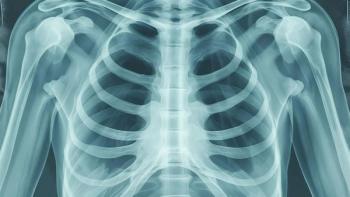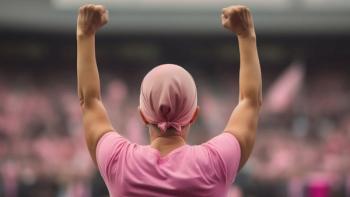
- 2021 Rare Cancers Special Issue
- Volume 9
Keeping Faith After a Sarcoma Diagnosis
After receiving a diagnosis of stage 3 sarcoma, one survivor proves that anything is possible.
In 2014, Nicole Body was a pharmaceutical representative in Colorado and just married the love of her life, Wes. Shortly after, she began experiencing gastrointestinal issues and would get sick whenever she ate certain foods. Body remembers trying different diets, seeing several specialists and getting more ultrasounds than she could count. In the summer of 2017, she stopped being able to tolerate food at all. “That had never happened before, and so we immediately made a doctor’s appointment to go in,” she explained.
What started out as another ultrasound led to a CT scan and then surgery to remove her gallbladder. The surgeons found a racquetball-sized tumor, which they partially removed. They sent the tumor for analysis and reassured Body that there was a less than 1% chance of it being cancerous.
Twelve days later, it came back as stage 3 undifferentiated pleomorphic sarcoma, also known as malignant fibrous histiocytoma, a rare type of cancer that forms in the soft tissue throughout the body and usually occurs in older patients. Body was 27 years old at the time. According to the Liddy Shriver Sarcoma Initiative, there are only a few thousand cases diagnosed annually.
“You hear that there’s a less than 1% chance that it’s going to be cancer, and then you get diagnosed with the cancer that less than 1% of people get,” Body said. “Our whole world stood still for a moment.”
The tumor was described as angry, aggressive and high grade, so they had to act —and fast. “We just kind of got our game faces on and were ready to do whatever it took,” she said.
Her surgeon recommended The University of Texas MD Anderson Cancer Center in Houston because it was a high-volume clinic. Coincidentally, Body’s parents had just relocated to Houston, erasing the stress that can come from finding and paying for a place to stay during treatment.
At her first appointment at MD Anderson, Body went through a series of tests in order to create a treatment plan. The health care team decided on six rounds of chemotherapy followed by radiation and a Whipple procedure, a major surgery that removes the head of the pancreas, the first part of the small intestine, the gallbladder and the bile duct. From there, the remaining organs are reattached so patients can digest food after surgery. Throughout treatment, Body faced every day with immense faith. She took up journaling to process her thoughts and prayed.
Body refers to Wes as “Superman” during this time because he went with Body to every treatment and never left her side. “He just always did everything that he could to try to make me laugh and smile so I didn’t feel like I was missing out on anything,” she said. “He created this new life for us to be living together, and they were some of the most beautiful moments I’ve ever experienced, even through the hardest season of my life.”
In November 2017, Body’s health care team stopped chemotherapy after four cycles, as the tumor was no longer responding to treatment, and admitted her to the hospital. They didn’t think she was going to make it. Having just turned 28, Body was planning her own funeral. She asked her husband to share her story, as well as her journal entries, to the world if she didn’t survive. “He said, ‘I promise you, but I have a feeling that it’s going to be you that gets to share it,” Body remembered.
And she did. One month later, on December 13, Body went in for the Whipple procedure. A nine-inch incision was made in her abdomen, but when the surgeon went in, the cancer was gone. “I’ve been cancer-free ever since,” she said.
Since then, Body has been able to publish her journal entries in her book, “When Love Broke Through,” and even started a blog titled “Sparkly Survivor.”
Navigating Fertility After Cancer
There was no time to preserve Body’s eggs because the time between diagnosis and treatment had occurred within 10 days. Upon analysis, doctors found that Body had lost 75% of her ovarian follicles; the other 25% were described to her as “shriveled.” Her levels of anti-Mullerian hormone, a substance that tells doctors about a woman’s fertility and egg count, were also low, and it wasn’t recommended for her to get pregnant for another two years after treatment.
Two years later, Wes and Body decided to go back for testing. “They said that 75% of my follicles had ‘woken up,’ and that if we got approval from the oncologist that we could try,” she said. “I was just blown away. I didn’t even know that follicles could wake up.”
They were given the green light, and within a month, the couple naturally conceived their daughter, who was born in May. “Just being able to share this part of my story of having stage 3, rare, aggressive cancer and being cancer-free for three-and-a-half years, and we have a baby even with aggressive chemo treatment. ... I just really hope that it brings encouragement in that anything is possible.”
For more news on cancer updates, research and education, don’t forget to
Editor's note: Since publishing this article, Body has experienced sarcoma recurrence.
Articles in this issue
over 4 years ago
Staying Aware of Gastric Cancer Risk Factors in Young Adultsover 4 years ago
Never Back Down: Lymphoma Survivor Stays Positiveover 4 years ago
The Power of Human Connection in Cancerover 4 years ago
Exploring Potential Treatment Options for Rare Cancersover 4 years ago
Life With von Hippel-Lindau Diseaseover 4 years ago
Navigating the Unknown of Rare Cancersover 4 years ago
Training for a Marathon: Managing Health After an MPN Diagnosisover 4 years ago
Novel App Informs Patients With Cancer of Unknown Primary



